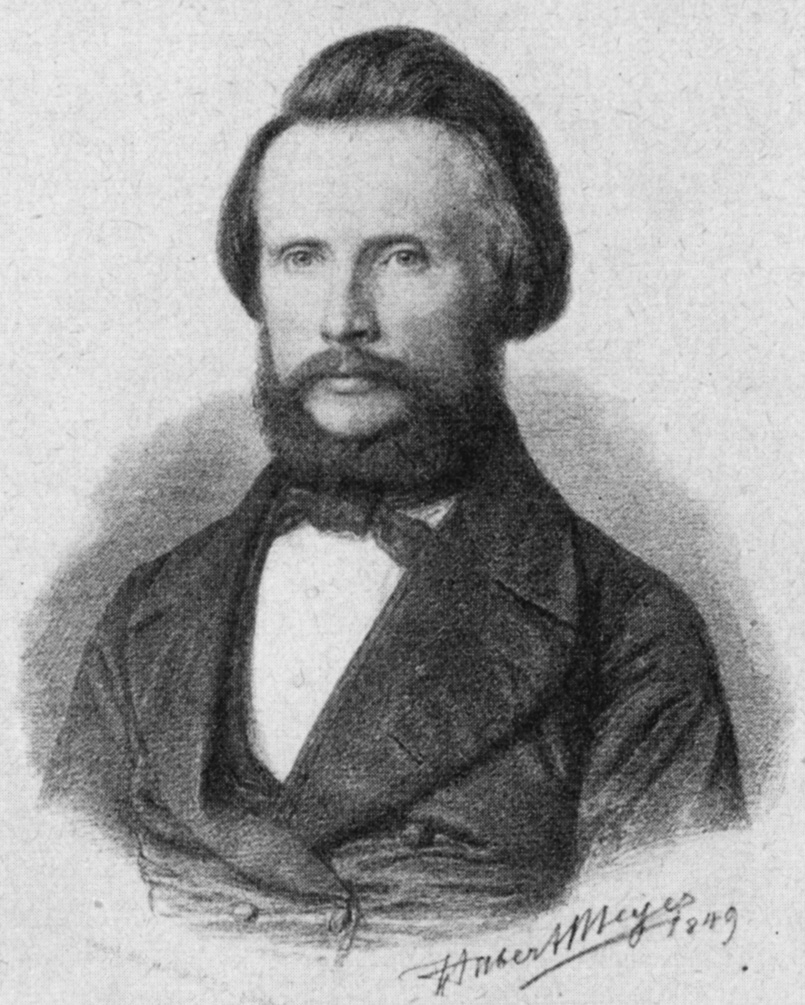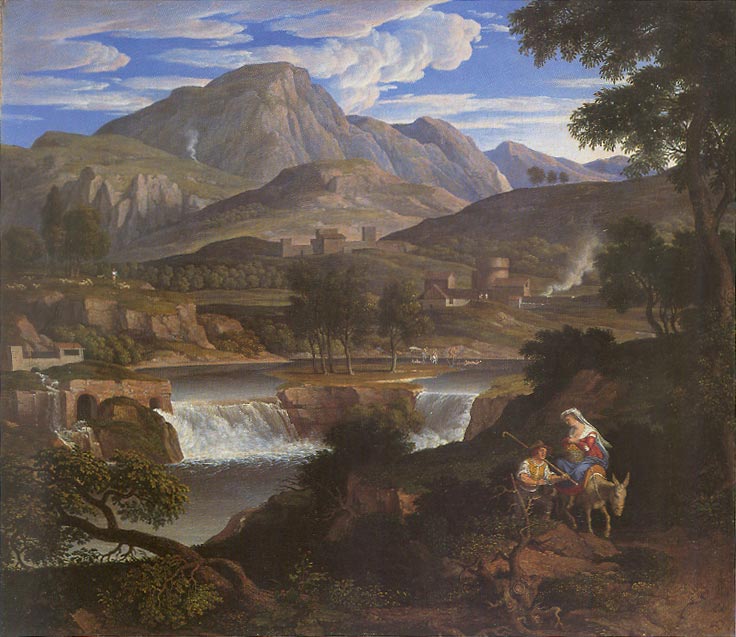|
Friedrich Mosbrugger
Friedrich Mosbrugger, also known as Fritz Moosbrugger (19 September 1804, in Konstanz – 17 October 1830, in Saint Petersburg) was a German portrait and genre painter in the Realistic style. He came from a family that had a widespread reputation as builders, plasterers and painters.*, included in the article on his father, Wendelin. His brother Joseph was also a painter, and his brother was an architect. Life His father was Wendelin Moosbrugger, a Court Painter for Frederick I of Württemberg. He received his first lessons from his father and another painter from Konstanz, Marie Ellenrieder, then studied at the Academy of Fine Arts, Munich, with Johann Peter von Langer After displaying some paintings at an exhibition in Karlsruhe in 1827, he followed his friend, the architect Friedrich Eisenlohr, to Italy and became a part of the German circle of artists resident in Rome. While there, he sought the opinions and advice of Joseph Anton Koch regarding his work. In the summer ... [...More Info...] [...Related Items...] OR: [Wikipedia] [Google] [Baidu] |
Friedrich Eisenlohr
Jakob Friedrich Eisenlohr (23 November 1805, in Lörrach – 27 February 1854, in Karlsruhe) was a German architect and university professor. His design for a cuckoo clock, now known as the Cuckoo clock#Bahnhäusle style, a successful design from Furtwangen, Bahnhäusle (train station) style, was the first to be mass-produced and helped make the clocks popular outside of Germany. Life and work His father, Jakob Friedrich Eisenlohr (1777–1854), was an evangelical pastor. From 1821 to 1824, he studied in Freiburg im Breisgau with the architect, .Peter Pretsch: "Friedrich Eisenlohr. Architekt der badischen Eisenbahn", In: ''Blick in die Geschichte'', Nr. 67, 24 June 2005Online After that, he moved to Karlsruhe, where he studied at the building school operated by Friedrich Weinbrenner. From 1826 to 1828, he continued his studies in Italy. After serving an apprenticeship, he became a teacher at the Polytechnischen Oberschule in Karlsruhe where, in 1839, he became a building offic ... [...More Info...] [...Related Items...] OR: [Wikipedia] [Google] [Baidu] |
German Genre Painters
German(s) may refer to: * Germany, the country of the Germans and German things **Germania (Roman era) * Germans, citizens of Germany, people of German ancestry, or native speakers of the German language ** For citizenship in Germany, see also German nationality law **Germanic peoples (Roman era) *German diaspora * German language * German cuisine, traditional foods of Germany People * German (given name) * German (surname) * Germán, a Spanish name Places * German (parish), Isle of Man * German, Albania, or Gërmej * German, Bulgaria * German, Iran * German, North Macedonia * German, New York, U.S. * Agios Germanos, Greece Other uses * German (mythology), a South Slavic mythological being * Germans (band), a Canadian rock band * "German" (song), a 2019 song by No Money Enterprise * ''The German'', a 2008 short film * "The Germans", an episode of ''Fawlty Towers'' * ''The German'', a nickname for Congolese rebel André Kisase Ngandu See also * Germanic (disambiguatio ... [...More Info...] [...Related Items...] OR: [Wikipedia] [Google] [Baidu] |
1830 Deaths
It is known in European history as a rather tumultuous year with the Revolutions of 1830 in France, Belgium, Poland, Switzerland and Italy. Events January–March * January 11 – LaGrange College (later the University of North Alabama) begins operation, becoming the first publicly chartered college in Alabama. * January 12 – Webster–Hayne debate: In the United States Congress, Robert Y. Hayne of South Carolina debates against Daniel Webster of Massachusetts about the question of states' rights vs. federal authority. The debate lasts until –January 27. * February 3 – The London Protocol (1830), London Protocol establishes the full independence and sovereignty of Greece from the Ottoman Empire, as the result of the Greek War of Independence. * February 5 – A fire destroys the Argyll Rooms in London, where the Philharmonic Society of London presents concerts, but firefighters are able to prevent its further spread by use of their new equipment, steam-powered fire e ... [...More Info...] [...Related Items...] OR: [Wikipedia] [Google] [Baidu] |
1804 Births
Events January–March * January 1 – Haiti gains independence from France, and becomes the first black republic. * February 4 – The Sokoto Caliphate is founded in West Africa. * February 14 – The First Serbian uprising begins the Serbian Revolution. By 1817, the Principality of Serbia will have proclaimed self-rule from the Ottoman Empire, the first nation-state in Europe to do so. * February 15 – New Jersey becomes the last of the northern United States to abolish History of slavery in New Jersey, slavery. * February 16 – First Barbary War: Stephen Decatur leads a raid to burn the pirate-held frigate at Tripoli, Libya, Tripoli to deny her further use by the captors. * February 18 – Ohio University is chartered by the Ohio General Assembly. * February 20 – Hobart is established in its permanent location in Van Diemen's Land (modern-day Tasmania) as a British penal colony. * February 21 – Cornwall, Cornishman Richard Trevithick's newly built ''Penydarren' ... [...More Info...] [...Related Items...] OR: [Wikipedia] [Google] [Baidu] |
Paul Emil Jacobs
Paul Emil Jacobs (August 20, 1802 in Gotha – January 6, 1866) was a German painter, noted for Orientalist themes, portraits and nudes. Life and career Jacobs, son of the philologist Frederick Jacobs, received his art training at the Munich Academy of Fine Arts and first became known for his painting of Mercury and Argus (from Classical mythology). In 1824 he went to Rome, where he attracted critical attention by painting "The Raising of Lazarus". In 1836 he made a series of historical paintings at the Welfenschloss in Hannover. Jacobs was noted for his mastery of nudes, expressed particularly in the representation of such Orientalist themes as "A slave market" or of sleeping and waking naked boys. Graceful depictions of the female body include his ''"A Harem Beauty At Her Toilette"'' and ''"Zither-playing Turk"''. His image of Scheherezade from ''Arabian Nights'' is noted for its light effects. The famous Ali Pasha was depicted by Jacobs in a moment of relaxed int ... [...More Info...] [...Related Items...] OR: [Wikipedia] [Google] [Baidu] |
Lübeck
Lübeck (; or ; Latin: ), officially the Hanseatic League, Hanseatic City of Lübeck (), is a city in Northern Germany. With around 220,000 inhabitants, it is the second-largest city on the German Baltic Sea, Baltic coast and the second-largest city in the state of Schleswig-Holstein, after its capital of Kiel. It is the List of cities in Germany by population, 36th-largest city in Germany. The city lies in the Holsatian part of Schleswig-Holstein, on the mouth of the Trave, which flows into the Bay of Lübeck in the borough of Travemünde, and on the Trave's tributary Wakenitz. The island with the historic old town and the districts north of the Trave are also located in the historical region of Wagria. Lübeck is the southwesternmost city on the Baltic Sea, and the closest point of access to the Baltic from Hamburg. The city lies in the Northern Low Saxon, Holsatian dialect area of Low German. The name ''Lübeck'' ultimately stems from the Slavic languages, Slavic root (' ... [...More Info...] [...Related Items...] OR: [Wikipedia] [Google] [Baidu] |
William I Of Württemberg
William I (; 27 September 178125 June 1864) was King of Württemberg from 30 October 1816 until his death. Upon William's accession, Württemberg was suffering crop failures and famine in the "Year Without a Summer", in 1816. After taking office, he initiated sweeping reforms, resulting in the approval of the Estates of Württemberg to a constitution on 25 September 1819. In his 48-year reign, the kingdom moved from one that was created from different denominational principalities and a heterogeneous agricultural country, into a constitutional state with a common identity and a well-organised management. In addition to his successful domestic policy, he pursued throughout his reign an ambition focused on German and European foreign policy. Alongside the great powers of Prussia and Austria, he imagined a third major German power in the form of Bavaria, Saxony, Hanover and Württemberg. Although this plan never succeeded, it ensured a consistent, coherent and targeted policy during ... [...More Info...] [...Related Items...] OR: [Wikipedia] [Google] [Baidu] |
Nicholas I Of Russia
Nicholas I, group=pron (Russian language, Russian: Николай I Павлович; – ) was Emperor of Russia, List of rulers of Partitioned Poland#Kings of the Kingdom of Poland, King of Congress Poland, and Grand Duke of Finland from 1825 to 1855. He was the third son of Paul I of Russia, Paul I and younger brother of his predecessor, Alexander I of Russia, Alexander I. Nicholas's thirty-year reign began with the failed Decembrist revolt. He is mainly remembered as a reactionary whose controversial reign was marked by geographical expansion, centralisation of administrative policies, and repression of dissent both in Imperial Russia, Russia and among its neighbors. Nicholas had a happy marriage that produced a large family, with all of their seven children surviving childhood. Nicholas's biographer Nicholas V. Riasanovsky said that he displayed determination, singleness of purpose, and an iron will, along with a powerful sense of duty and a dedication to very hard work. ... [...More Info...] [...Related Items...] OR: [Wikipedia] [Google] [Baidu] |
Sabine Hills
Sabina (Latin: ''Sabinum''), also called the Sabine Hills, is a region in central Italy. It is named after Sabina, the territory of the ancient Sabines, which was once bordered by Latium to the south, Picenum to the east, ancient Umbria to the north and Etruria to the west. It was separated from Umbria by the River Nar, today's Nera, and from Etruria by the River Tiber. Today, Sabina is mainly northeast of Rome in the regions Lazio, Umbria and Abruzzo. ''Upper Sabina'' is in the province of Rieti ( Poggio Mirteto, Magliano Sabina, Casperia, Montopoli di Sabina, Torri in Sabina, Cantalupo in Sabina, Montebuono, Forano, Poggio Catino, Montasola, Stimigliano, Castelnuovo di Farfa, Fara in Sabina, Roccantica, Mompeo, Salisano, Cottanello, Configni, Vacone, Tarano, Collevecchio, Toffia, Poggio Nativo, Scandriglia ecc.). ''Sabina Romana'' is in the province of Rome (Mentana, Monteflavio, Montelibretti, Monterotondo, Montorio Romano, Moricone, Nerola, Palombara Sabina). Part ... [...More Info...] [...Related Items...] OR: [Wikipedia] [Google] [Baidu] |
Joseph Anton Koch
Joseph Anton Koch (27 July 1768 – 12 January 1839) was an Austrian painter of Neoclassicism and later the German Romantic movement; he is perhaps the most significant neoclassical landscape painter. Biography The Tyrolese painter was born in Elbigenalp. Early in his life he was tending cattle. Through the recommendation of Bishop Umgelder (1785), he received academic training in the Karlsschule Stuttgart, a strict military academy. In 1791, he ran away, and traveled through France and Switzerland. He arrived in Rome in 1795. Koch was close to the painter Asmus Jacob Carstens and carried on Carstens' "heroic" art, at first in a literal manner. He etched the pages of Carstens' ''Les Argonautes, selon Pindar, Orphée et Apollonius de Rhode'' (Rome, 1799). After 1800, Koch developed as a landscape painter. In Rome, he espoused a new type of "heroic" landscape, revising the classical compositions of Poussin and Lorrain with a more rugged, mountainous scenery. In 1812, forc ... [...More Info...] [...Related Items...] OR: [Wikipedia] [Google] [Baidu] |









